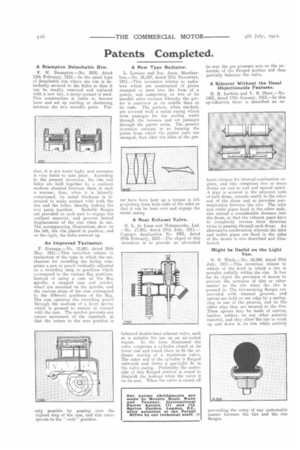Patents Completed.
Page 38

If you've noticed an error in this article please click here to report it so we can fix it.
A Brampton Detachable Rim.
F. W. Brampton.—No. 3835, dated 15th February, 1912.—In the usual type of detachable rim where one rim is detachably secured to the felloe so that it can be readily removed and replaced with a new tire, a metal contact is used. This construction is liable to become loose and set up rattling or chattering between the two metallic parts. Fur ther, it is not water tight, and corrosion is very liable to take place. According to the present invention, the rim and felloe are held together by a resilient medium situated between them in such a manner, that, when it is laterally compressed, its radial thickness is increased to make contact with both the rim and the felloe, thereby locking the two parts together. Suitable flanges are provided on each part to engage the resilient material, and prevent lateral displacement of the rim when in use. The accompanying illustrations show on the left, the rim placed in position, and on the right, the bolts screwed up.
An Improved Taximeter.
F. Gienapp.—No. 12,801, dated 29th May, 1911.—This invention relates to taximeters of the type in which the mechanism for recording the hiring comprises a pen or pencil vertically adjusted on a recording strip to positions which correspond to the various flag positions. Instead of using a cam on the flag spindle, a stepped cam and ratchet wheel are mounted on the spindle, and the various steps of the cam correspond to the different positions of the flag. The cam operates the recording pencil through the medium of a lever spring, which is pressed to remain in contact with the cam. The ratchet prevents any return movement of the camshaft, so that the return to the zero position is only possible by passing over the highest step of the cam, and this corresponds to the " cash " position.
A New Type Radiator.
L. Loziano and Soc. Anon. Montbarbon.—No. 26,557, dated 27th November, 1911.—This invention relates to radiators which are constructed of plates stamped or bent into the form of a gutter, and comprising on two of its parallel sides recesses whereby the gutter is narrower at its middle than at its ends. The gutters, when stacked, are covered with a metal casing which form passages for the cooling water through the recesses and air passages through the gutter units. The present invention consists in so forming the plates from which the gutter units are stamped, that after the sides of the gut ter have been bent up a tongue is left projecting from both ends of the sides so that it can be bent over and engage the metal casing.
A Neat Exhaust Valve.
0. L. de Lissa and Motosacoche, Ltd. —No. 17,201, dated 27th _July, 1911.— Cognate Application No. 4491, dated 27th February, 1912.—The object of this invention is to provide an air-cooled balanced double-beat exhaust valve, such as is suitable for use on an air-cooled engine. In the form illustrated the valve comprises a cylinder closed at its lower end and coned there to fit the ordinary seating of a, mushroom valve. The outer end of the cylinder is flanged outwards and forms a gas-tight fit in the valve casing. Preferably the underside of this flanged portion is coned to diminish the leakage when the valve is on its seat. When the valve is raised off its seat the gas pressure acts on the underside of the flanged portion and thus partially balances the valve.
A Silencer Without the Usual Objectionable Features.
H. H. Larkins and V. R. Shaw.—No. 1402, dated 17th January, 1912.—In this specification there is described an ex haust silencer for internal-combustion engines, and this comprises two or more drums set end to end and spaced apart. A pipe is secured in the adjacent ends of each drum, extends nearly to the other end of the drum and so provides communication between the two. The inlet and outlet pipes fixed in the other ends, also extend a considerable distance into the drum, so that the exhaust gases have to completely reverse their direction twice in passing through each drum. An alternative construction wherein the inlet and outlet pipes are fixed in the sides of the drums is also described and illustrated.
Might be Usefut on the Light
Van.
0. H. Hinds.—No. 16,949, dated 24th July, 1911.—This invention relates to wheels of the kind in which a tire is movable radially within the rim. It has for its object the provision of means to prevent the entrance of dirt or other matter to the rim when the tire is pressed in. The tire-securing flanges are provided with internal grooves, and aprons are held on one edge by a springring in one of the grooves, and on the other edge they are secured to the tire. These aprons may he made of canvas, leather, rubber, on any other suitable material, and they allow the tire to work up and down in its rim while entirely
preventing the entry of any undesirable matter between the tire and the rim flanges.






































